Toward a “Smart-Green” Future in Cities: System Dynamics Study of Megacities in China
Abstract
:1. Introduction
2. Literature Review
2.1. Bibliometric Analysis
2.2. Study on the Effect Smart Cities Exert on Green Development
2.3. Research Gaps
3. Data and Methodology
3.1. Research Objects
3.2. Research Framework
3.3. Data and Indicator System
3.4. System Dynamic Model
4. Results and Discussion
4.1. Development Level of Smart Cities
4.2. Trend of Green Development
4.2.1. Industrial Structure Scenarios
- (1)
- Increased demand for services: As the tertiary sector develops, there is an increased demand for services such as transportation, logistics, communication, tourism, and entertainment. These services often require energy, such as fuel and electricity, for transportation and energy consumption by information technology equipment. For megacities, the increased demand for services may exacerbate the “urban diseases”, which may have an amplifying effect on energy consumption.
- (2)
- Energy consumption in commercial and office buildings: With the growth of the service industry, the number of commercial and office buildings also increases. These buildings require lighting, heating, ventilation, and air conditioning infrastructure, which often consume significant amounts of energy. The developers tend to build skyscrapers that rely on air conditioners and fresh air ventilation systems in megacities. This kind of building costs much more energy than traditional ones.
- (3)
- Energy consumption in digitization and information technology: With the digitization and widespread use of information technology in the tertiary sector, there is a corresponding increase in energy consumption from various devices, servers, and data centers. Technologies such as cloud computing, big data analytics, and artificial intelligence all require substantial energy support.
4.2.2. Science and Technology Scenarios
- (1)
- Increased investment in technology often leads to advancements in production and consumption activities, resulting in higher energy demands. For example, technological progress can lead to the emergence of new energy-intensive industries and products in megacities, such as data centers, cloud computing, and smart devices, all of which require significant energy supply.
- (2)
- Increased quantity of equipment and facilities: An increase in technology investment is often accompanied by an expansion in the quantity of equipment and facilities, such as factories, laboratories, and offices. The operation of this equipment and these facilities requires energy supply, thereby increasing energy consumption.
- (3)
- Manufacturing and disposal of electronic devices: Increased technology investment means more electronic devices and computer systems, which consume energy during their manufacturing, usage, and disposal processes. The manufacturing of electronic devices involves the extraction, processing, and transportation of raw materials, while the usage and disposal of devices require electricity and other resources.
4.2.3. Environmental Investment Rate
- (1)
- Small difference in scenario settings: China is already one of the top countries that invest in environmental protection, especially its megacities, which represent the frontier of China’s development. So, the difference between the current and high scenarios is very small.
- (2)
- Technology and equipment upgrade cycles: Environmental protection investment often involves upgrading and replacing existing technologies and equipment to improve energy efficiency and reduce pollutant emissions. However, equipment replacement and technology upgrades often require time and money, especially for large-scale production facilities. In such cases, the impact of environmental protection investment may require a longer cycle to be reflected in energy consumption.
- (3)
- Environmental protection investment often entails high costs, such as purchasing energy-efficient equipment, implementing cleaner production processes, or adopting renewable energy sources. These costs may impose financial burdens on businesses, particularly during the initial investment phase, which could lead to significant decreases in energy consumption.
4.2.4. Per Capita Scenario
4.3. Relationship between “Smart” and “Green” Development
5. Conclusions and Policy Implications
5.1. Conclusions
5.2. Policy Implications
5.3. Future Work
- (1)
- The scope of the research can be expanded. This research is based on seven megacities in China, but future work could encompass broader objectives beyond China. This research framework holds applicability for all developing countries currently undergoing rapid urbanization processes.
- (2)
- The scenarios can be further enriched. As indicated in Section 2.1, various factors can influence the level of green development. While this study includes industrial structure, environmental protection investment, and R & D investment, it would also be intriguing to explore additional variables such as population dynamics, policy impacts, and other relevant factors.
Author Contributions
Funding
Data Availability Statement
Conflicts of Interest
References
- Corbusier, L. The City of Tomorrow and Its Planning: The City of Tomorrow and Its Planning; John Wiley & Sons: Malden, MA, USA, 1987. [Google Scholar]
- Angelidis, M. Smart green just city actions versus urban planning in European union. Sustain. Dev. Cult. Tradit. J. 2021, 1, 60–80. [Google Scholar] [CrossRef]
- Xie, Z.; Wu, R.; Wang, S. How technological progress affects the carbon emission efficiency? Evidence from national panel quantile regression. J. Clean. Prod. 2021, 307, 127133. [Google Scholar]
- Pan, J. Scientific planning as the key to new-type of ecologically friendly urbanization. Environ. Prot. 2014, 42, 14–18. [Google Scholar]
- Gibson, D.V.; Kozmetsky, G.; Smilor, R.W. (Eds.) The Technopolis Phenomenon: Smart City, Fast Systems, Global Networks; Rowman & Littlefield: Lanham, MD, USA, 1992. [Google Scholar]
- Li, F.; Yang, H.; Gao, X.; Han, H. Towards IoT-based sustainable digital communities. Intell. Converg. Netw. 2022, 3, 14. [Google Scholar] [CrossRef]
- De Aguiar, C.; Leshed, G.; Pinch, T.; Green, K. Evaluation of communIT, a large-scale, cyber-physical artifact supporting diverse subgroups building community. J. Smart Cities Soc. 2022, 1, 165–178. [Google Scholar] [CrossRef]
- Cristiano, E.; Deidda, R.; Viola, F. The importance of green roofs in an urban Water-Energy-Food-Ecosystem nexus context. In EGU General Assembly Conference Abstracts; EGU: München, Germany, 2021. [Google Scholar] [CrossRef]
- Otieno, J.P.; Duncan, M.; Oluoch, P. Climate Neutral Icpac (Smart City, Transport & Energy, Software & Data). 2021. Available online: https://www.researchgate.net/publication/354585953_CLIMATE_NEUTRAL_ICPACSMART_CITY_TRANSPORT_ENERGYSOFTWARE_DATA (accessed on 15 January 2022).
- Sembiring, M. Smart City Development: Supporting Climate Resilience in Southeast Asia? Non-Traditional Security in the Asia-Pacific. In Non-Traditional Security in the Asia-Pacific: A Decade of Perspectives; World Scientific: Singapore, 2021. [Google Scholar]
- Hadidi, L.A.; Rahman, S.M.; Maghrabi, A.T. Smart city—A sustainable solution for enhancing energy efficiency and climate change mitigation in Saudi Arabia. Int. J. Glob. Warm. 2021, 24, 91–107. [Google Scholar] [CrossRef]
- Wang, Y.; Jiulin, L.I.; Kangkang, G.U.; Lin, L.U. Optimization of urban green infrastructure network layout based on MSPA-CIRCUIT: Case of Hefei. Acta Ecol. Sin. 2022, 42, 2022–2032. [Google Scholar]
- Ou, X.; Lyu, Y.; Liu, Y.; Zheng, X.; Li, F. Integrated multi-hazard risk to social-ecological systems with green infrastructure prioritization: A case study of the Yangtze River Delta, China. Ecol. Indic. 2022, 136, 108639. [Google Scholar] [CrossRef]
- Gulsecen, S.; Gezer, M.; Celik, S.; Koolu, F.N. Future needs from the Smart Mega City (SMC) plans smart green city the case of Istanbul. In Sustainable Mega City Communities; Butterworth-Heinemann: Oxford, UK, 2021. [Google Scholar]
- Lee, S.H.; Lee, D.W. Smart Convergence—The Future of Green City. J. Digit. Converg. 2012, 10, 233–237. [Google Scholar]
- Anthopoulos, L. Evaluating Green Smart City’s Sustainability with an Integrated System Dynamics Model. In Proceedings of the CeDEM Asia 2014: Conference for E-Democracy an Open Government, Hong Kong, China, 4–5 December 2014; MV-Verlag: Greifswald, Germany, 2015. [Google Scholar]
- Oad, A.; Ahmad, H.G.; Talpur, M.S.H.; Zhao, C.; Pervez, A. Green smart grid predictive analysis to integrate sustainable energy of emerging V2G in smart city technologies. Optik 2023, 272, 170146. [Google Scholar] [CrossRef]
- Qureshi, K.N.; Hussain, R.; Jeon, G. A distributed software defined networking model to improve the scalability and quality of services for flexible green energy internet for smart grid systems. Comput. Electr. Eng. 2020, 84, 106634. [Google Scholar] [CrossRef]
- Zhang, X.; Manogaran, G.; Muthu, B. IoT enabled integrated system for green energy into smart cities. Sustain. Energy Technol. Assess. 2021, 46, 101208. [Google Scholar] [CrossRef]
- Mukherjee, P.; Patra, S.S.; Pradhan, C.; AL-Amodi, S.; Barik, R.K. Green Energy Powered by Smart Grids: A Business Model for Long Term Sustainability. In Proceedings of the Cyber Technologies and Emerging Sciences: ICCTES 2021, Uttarakhand, India, 17–18 December 2021; Springer: Singapore, 2022. [Google Scholar]
- Cao, W.; Zhang, Y.; Qian, P. The effect of innovation-driven strategy on green economic development in China—An empirical study of smart cities. Int. J. Environ. Res. Public Health 2019, 16, 1520. [Google Scholar] [CrossRef]
- Tian, H.; Qing, S. Can innovation-driven approaches promote the sustainable economic development of smart cities? Sci. Technol. Prog. Policy 2018, 35, 6–12. [Google Scholar]
- Bibri, S.E.; Krogstie, J. Smart sustainable cities of the future: An extensive interdisciplinary literature review. Sustain. Cities Soc. 2017, 31, 183–212. [Google Scholar] [CrossRef]
- Silva, B.N.; Khan, M.; Han, K. Towards sustainable smart cities: A review of trends, architectures, components, and open challenges in smart cities. Sustain. Cities Soc. 2018, 38, 697–713. [Google Scholar] [CrossRef]
- Martin, C.; Evans, J.; Karvonen, A.; Paskaleva, K.; Yang, D.; Linjordet, T. Smart-sustainability: A new urban fix? Sustain. Cities Soc. 2019, 45, 640–648. [Google Scholar] [CrossRef]
- Ahvenniemi, H.; Huovila, A.; Pinto-Sepp, I.; Airaksinen, M. What are the differences between sustainable and smart cities? Cities 2017, 60, 234–245. [Google Scholar] [CrossRef]
- Gazzola, P.; Del Campo, A.G.; Onyango, V. Going green vs. going smart for sustainable development: Quo vadis? J. Clean. Prod. 2019, 214, 881–892. [Google Scholar]
- Yao, T.; Huang, Z.; Zhao, W. Are smart cities more ecologically efficient? Evidence from China. Sustain. Cities Soc. 2020, 60, 102008. [Google Scholar] [CrossRef]
- Viitanen, J.; Kingston, R. Smart cities and green growth: Outsourcing democratic and environmental resilience to the global technology sector. Environ. Plan. A 2014, 46, 803–819. [Google Scholar]
- Shi, D. Evolution of industrial development trend under digital economy. China’s Ind. Econ. 2022, 11, 26–42. [Google Scholar]
- Jiang, X.; Wang, L. Industrial structure upgrading effect of smart city policy: An empirical study based on multi-period DID. Forum Sci. Technol. China 2021, 12, 31–40. [Google Scholar]
- Lichao, W.; Li, W.; Chen, L.; Li, J. The impact of smart city construction on green technology innovation: An empirical study based on panel data of prefecture-level cities. Technol. Econ. 2022, 41, 1–16. [Google Scholar]
- Cheng, Z.; Wang, L.; Zhang, Y. Does smart city policy promote urban green and low-carbon development? J. Clean. Prod. 2022, 379, 134780. [Google Scholar]
- Huang, H.; Xie, Y.; Li, N. Does Smart City Construction Promote Low-carbon Development? Urban Dev. Stud. 2022, 29, 105–112. [Google Scholar]
- Fan, H.; Mi, X. Research on the construction of smart cities and green economy transformation of cities. Urban Probl. 2021, 11, 96–103. [Google Scholar]
- Liu, K.; Meng, C.; Tan, J.; Zhang, G. Do smart cities promote a green economy? Evidence from a quasi-experiment of 253 cities in China. Environ. Impact Assess. Rev. 2023, 99, 107009. [Google Scholar] [CrossRef]
- Lin, X.; Wang, D. Can smart city construction promote green development—Evidence based on “quasi natural experiment”. Technol. Econ. 2022, 41, 104–113. [Google Scholar]
- Filiou, D.; Kesidou, E.; Wu, L. Are smart cities green? The role of environmental and digital policies for Eco-innovation in China. World Dev. 2023, 165, 106212. [Google Scholar]
- Tian, H.; Song, Q. Can innovation-driven promote the green development of smart city economy—An empirical analysis based on the panel data of 47 cities in China. Sci. Technol. Prog. Policy 2018, 35, 6–12. [Google Scholar]
- Liu, Y.; Li, Q.; Zhang, Z. Do Smart Cities Restrict the Carbon Emission Intensity of Enterprises? Evidence from a Quasi-Natural Experiment in China. Energies 2022, 15, 5527. [Google Scholar]
- Du, J.; Wang, Y.; Zhao, A. The Effects and Machanism of Smart City Construction on Urban Green Development. Soft Sci. 2020, 34, 59–64. [Google Scholar]
- Zhang, J.; Li, Q. Influence of Smart City Construction on Urban Technology Innovation. Technol. Prog. Policy 2020, 37, 38–44. [Google Scholar]
- Wang, K.L.; Pang, S.Q.; Zhang, F.Q.; Miao, Z.; Sun, H.P. The impact assessment of smart city policy on urban green total-factor productivity: Evidence from China. Environ. Impact Assess. Rev. 2022, 94, 106756. [Google Scholar]
- Zhang, E.; He, X.; Xiao, P. Does Smart City Construction Decrease Urban Carbon Emission Intensity? Evidence from a Difference-in-Difference Estimation in China. Sustainability 2022, 14, 16097. [Google Scholar]
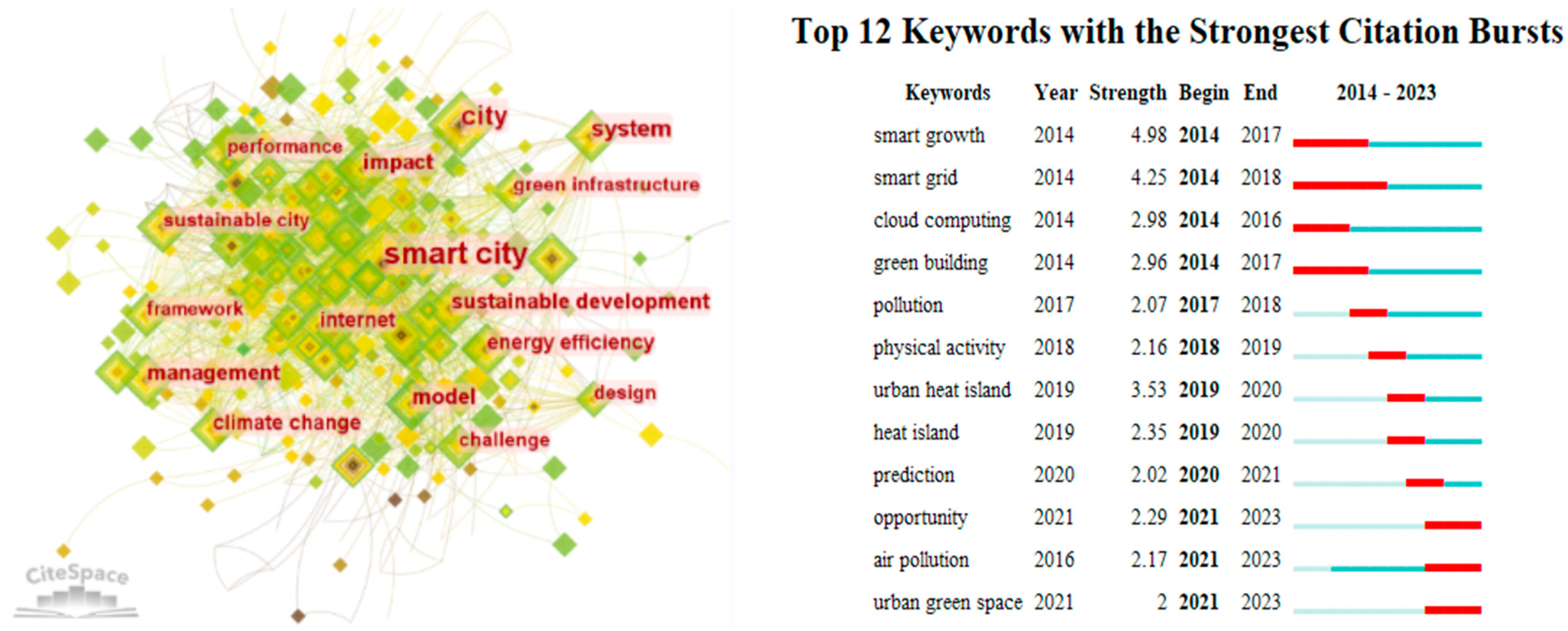
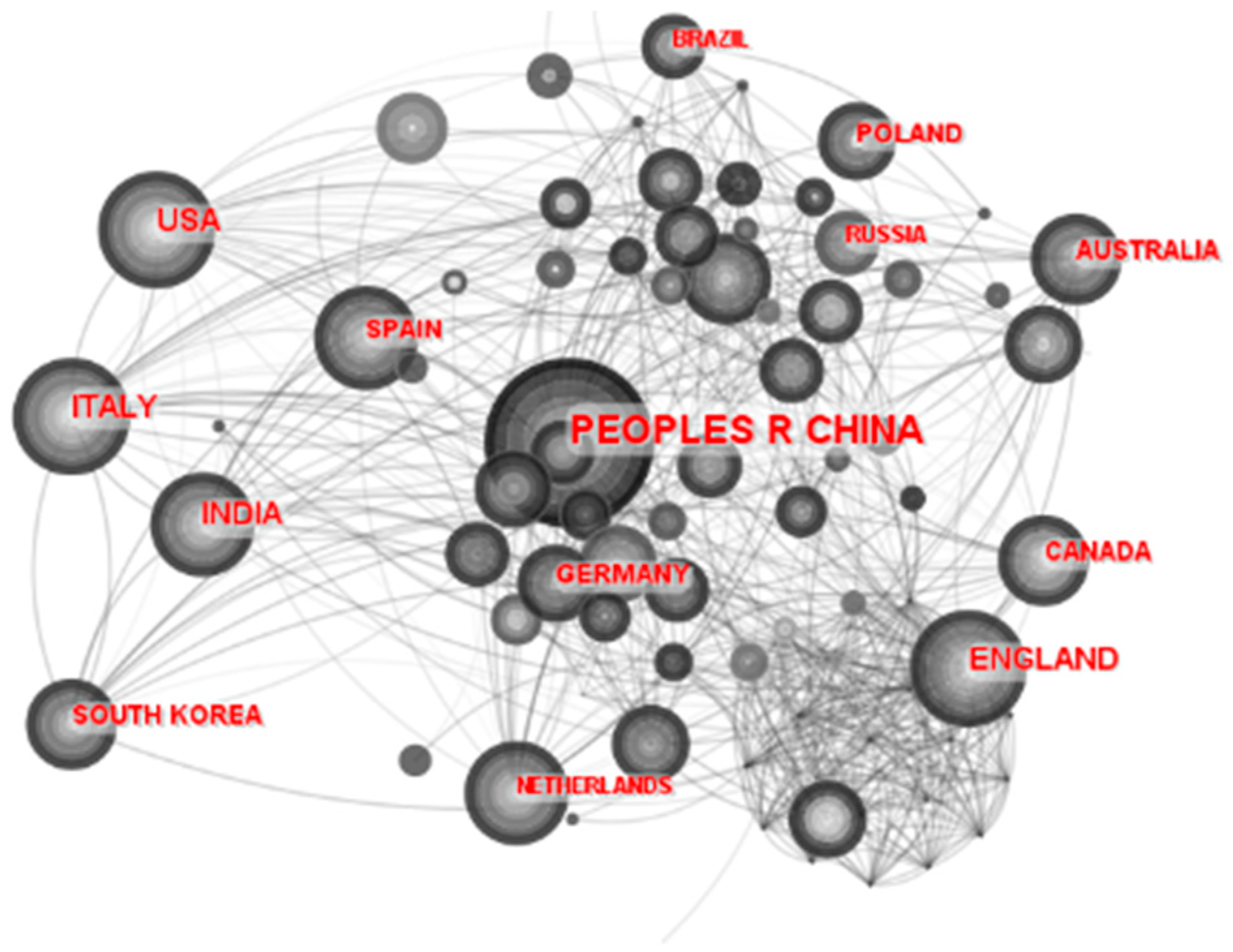
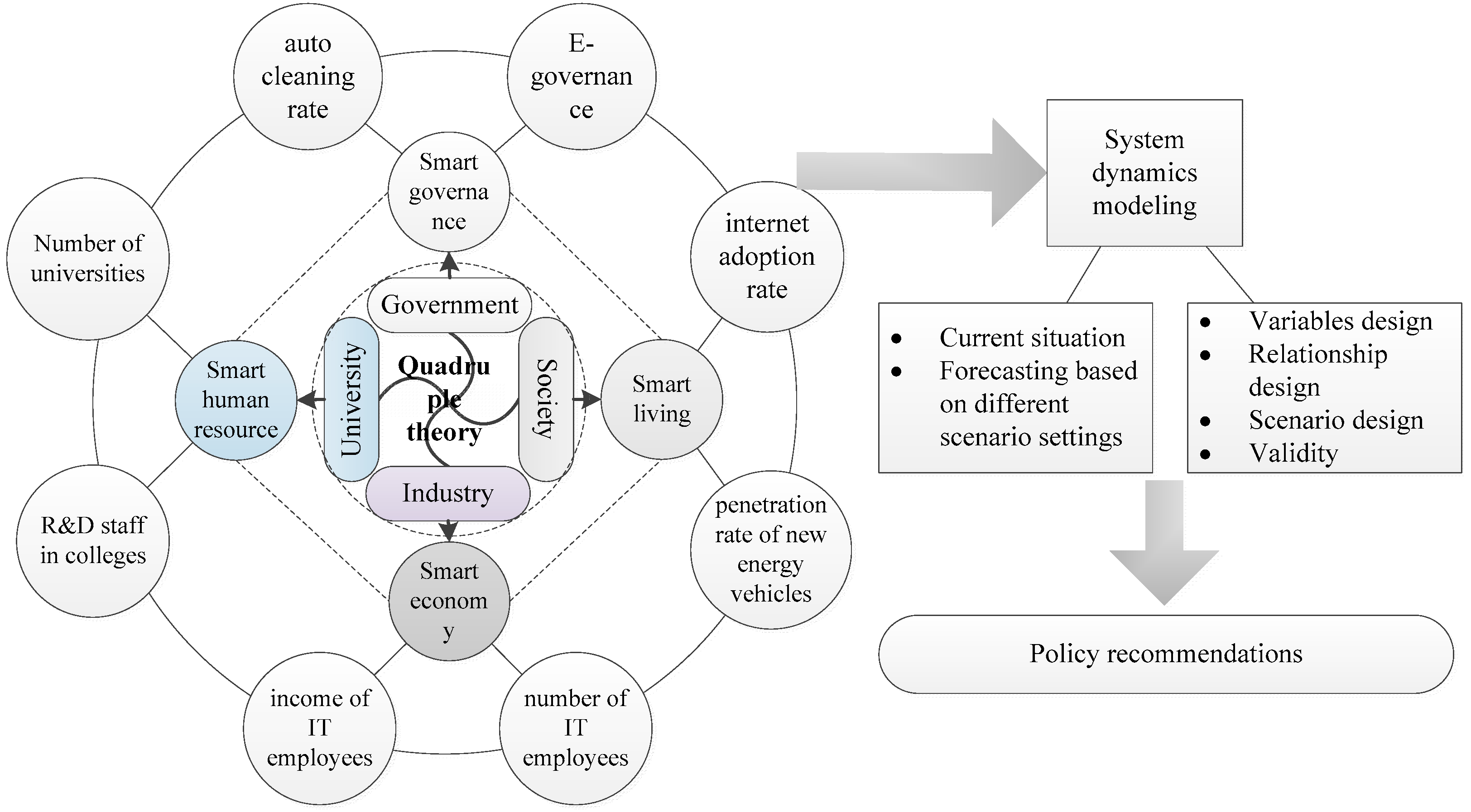
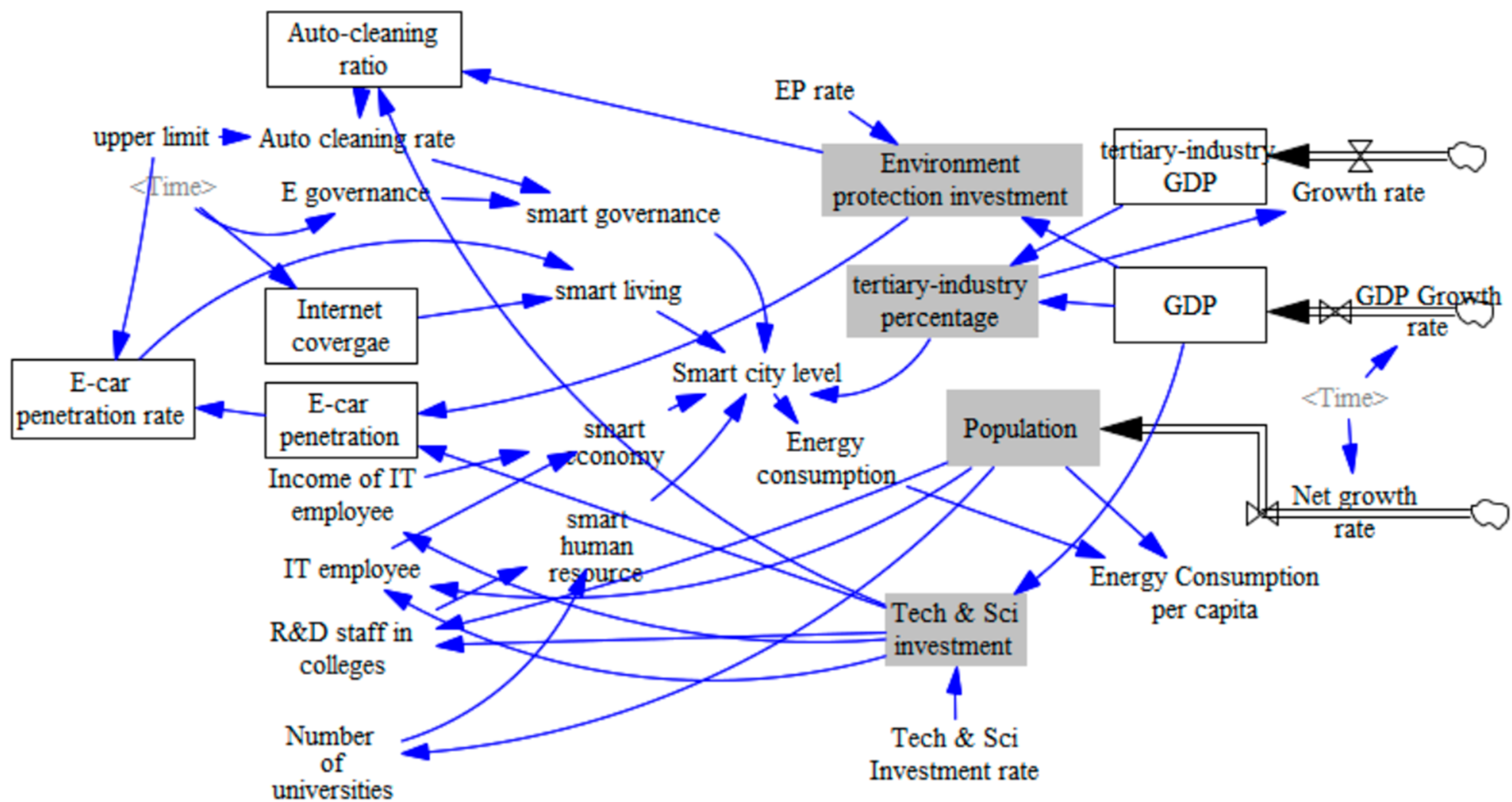
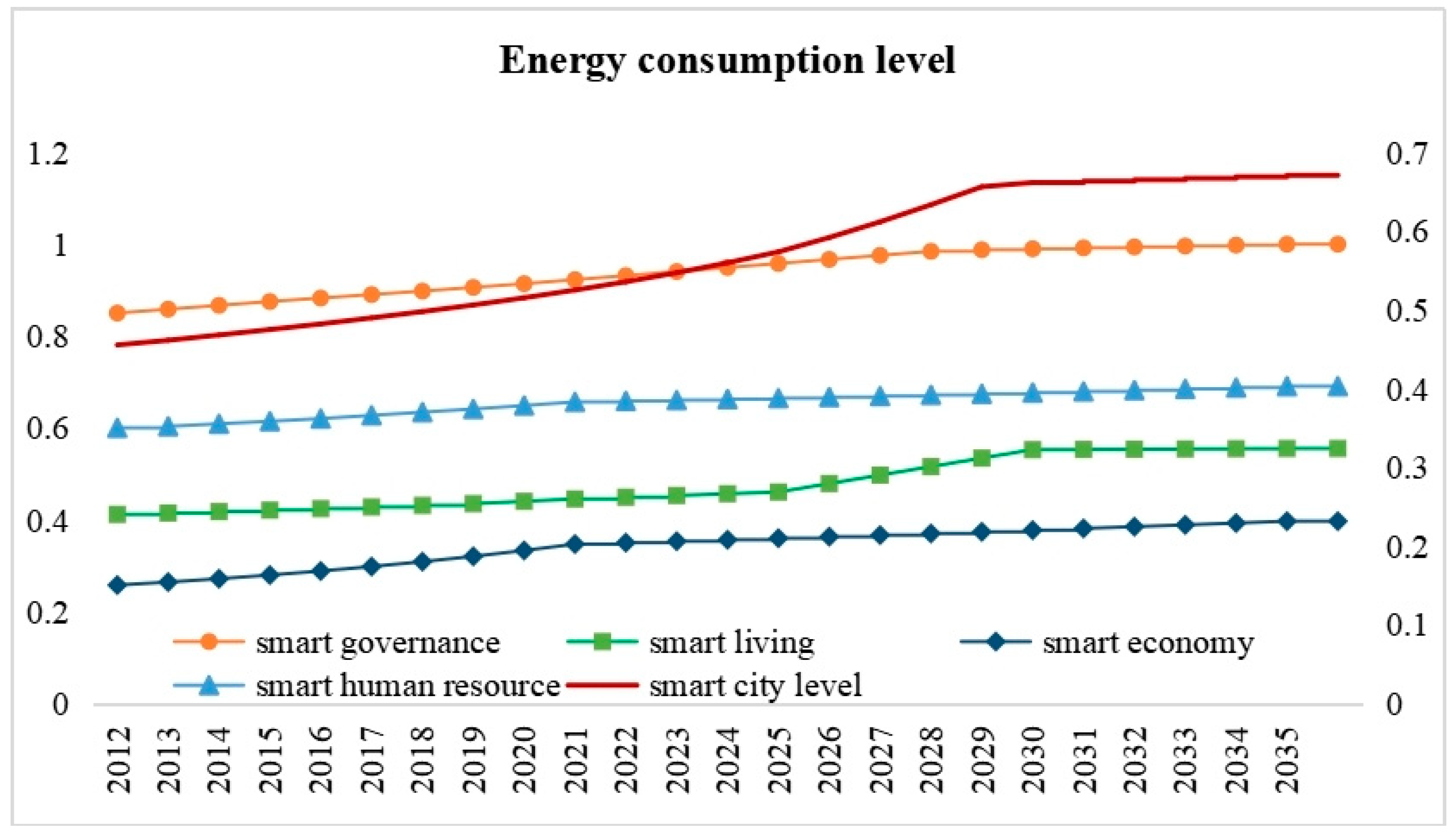


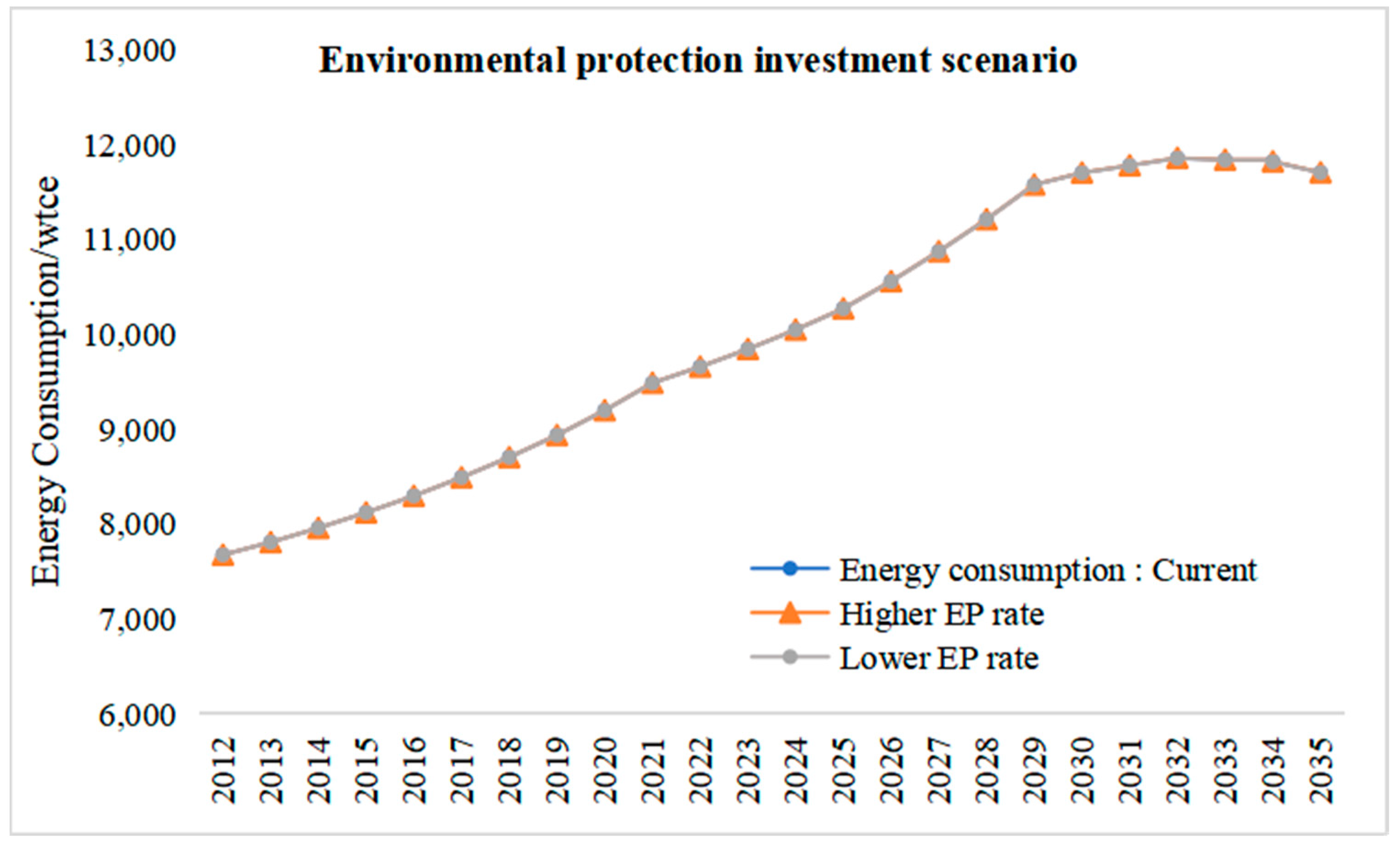
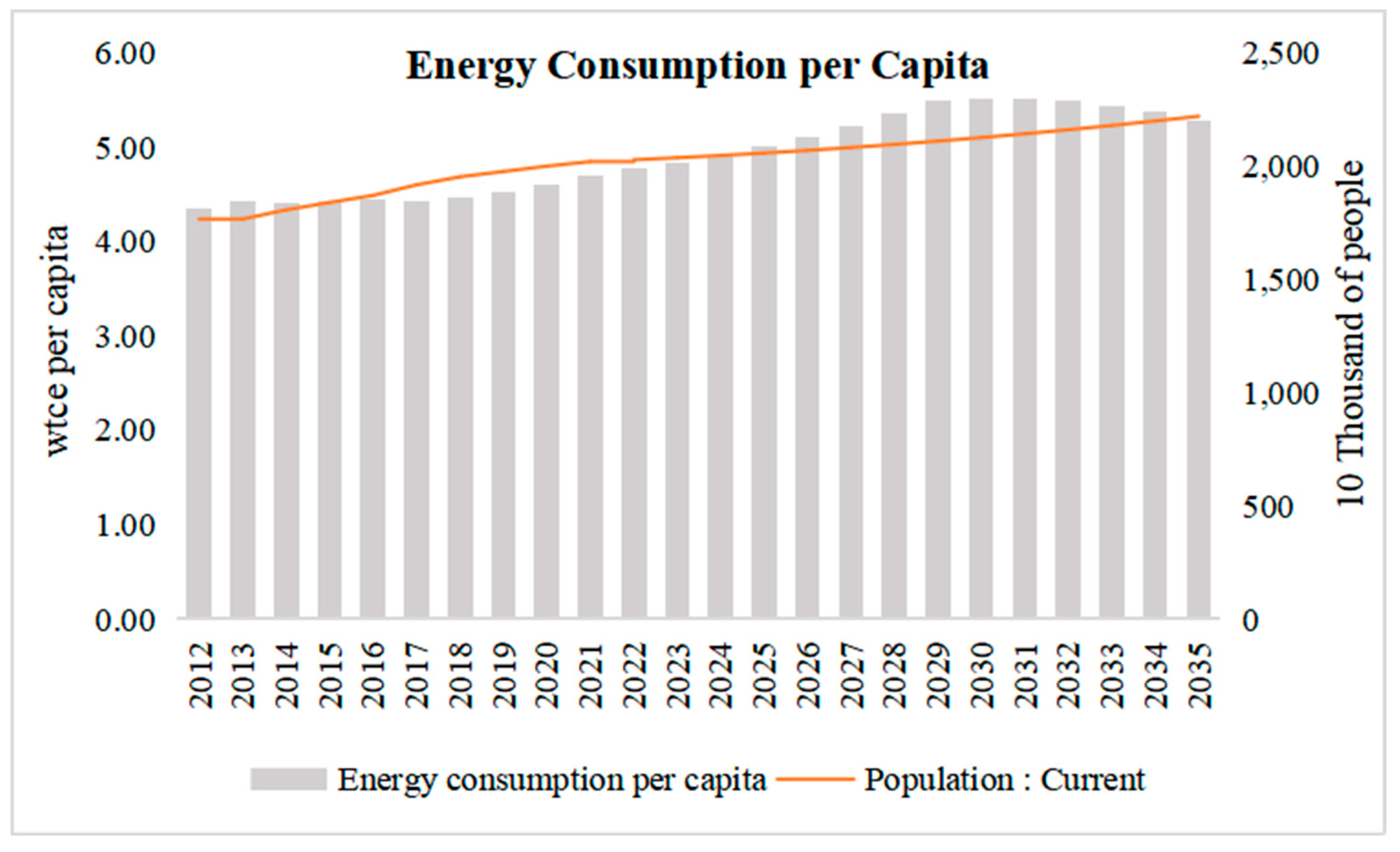
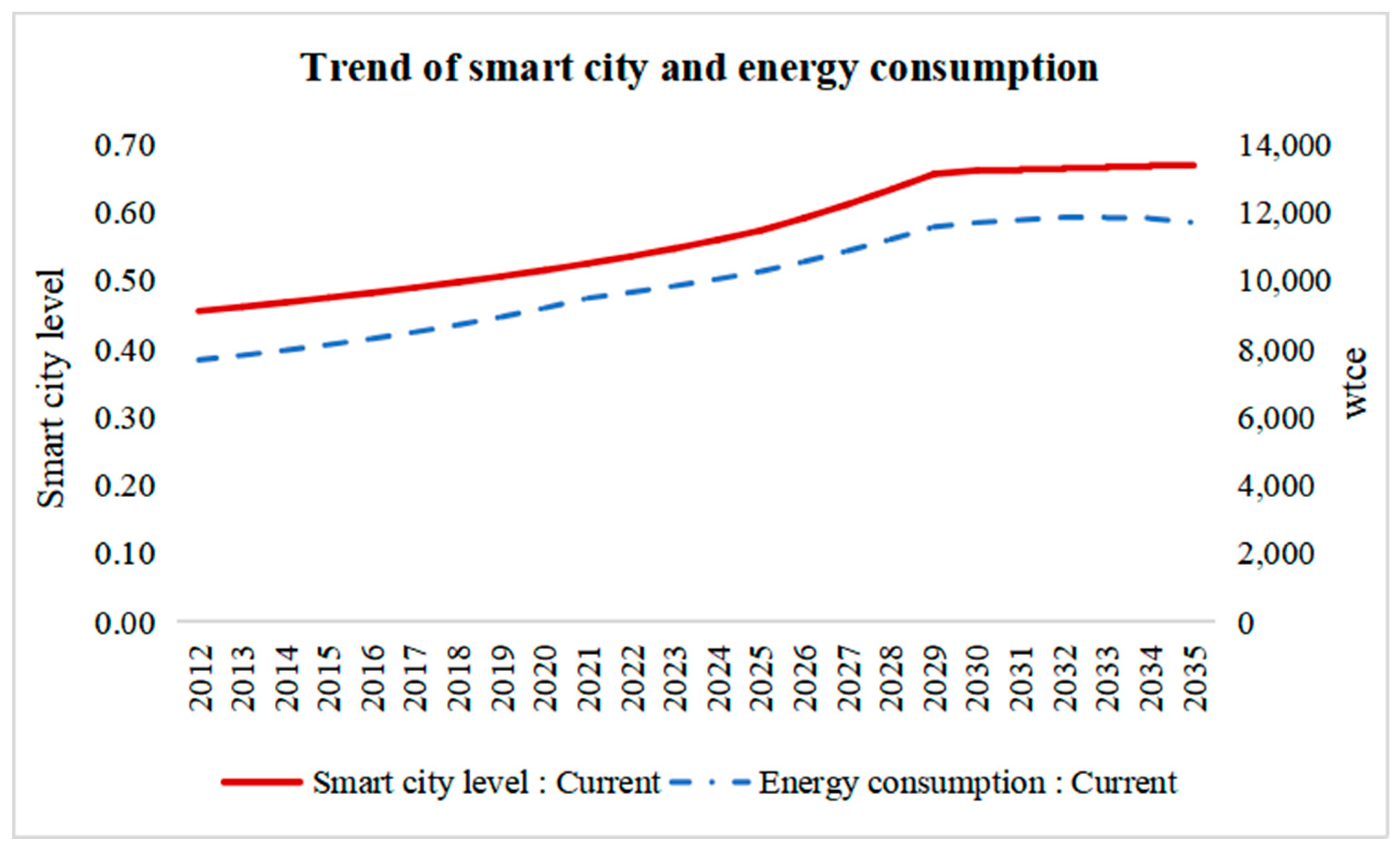
| Main Idea | Source | |
|---|---|---|
| Mechanism test | The increased proportion of science and technology expenditure in financial expenditure promotes the low-carbon development of cities. | [31,32,33] |
| The development of the information industry promotes the upgrading of industrial structure and thus promotes the low-carbon development of cities. | [34,35,36] | |
| Promotes urban low-carbon development through technological innovation. | [31,37,38] | |
| Promotes urban low-carbon development by optimizing urban resource allocation. | [34,39,40] | |
| Reduces the scale of government to offset its impact on green development. | [41] | |
| Heterogeneity | Smart city construction has a more significant effect on carbon reduction in cities with low financial development levels, high human capital levels, and low export-oriented economy levels. | [42] |
| The effect is more significant in western cities, southern cities, non-environmentally friendly cities, resource-based cities, and non-provincial capital cities. | [34,43] | |
| The effect of carbon reduction in underdeveloped cities, megacities, and highly administrative cities is more significant. | [33,35,41] | |
| The effect of carbon reduction in cities with obvious economic agglomeration advantages and strict environmental regulations is more significant. | [37,44] |
| Smart Governance | Smart Living | Smart Economics | Smart Human Resource | Green Development Level | ||||||
|---|---|---|---|---|---|---|---|---|---|---|
| Auto-Cleaning Ratio | E-Governance | Internet Coverage | E-Car Coverage | Income of IT Employees | Number of IT Employees | R & D Staff in Colleges | Number of Universities | Energy Consumption | ||
| Unit | CNY | 10,000 People | People | Universities | Wtce | |||||
| Beijing | 2013 | 0.9 | 0.97 | 0.752 | 0.11 | 136,599 | 58.24 | 18,600 | 89 | 6723.9 |
| 2015 | 0.9 | 0.97 | 0.765 | 0.11 | 159,486 | 68.007 | 19,540 | 90 | 6852.6 | |
| 2017 | 0.9 | 0.97 | 0.8 | 0.19 | 183,183 | 77.44 | 20,000 | 92 | 7132.8353 | |
| 2019 | 0.9 | 0.97 | 0.85 | 0.19 | 234,121 | 85.9131 | 22,000 | 93 | 7360.32 | |
| 2021 | 0.9 | 0.97 | 0.9 | 0.08 | 290,038 | 86.5 | 23,000 | 92 | 7103.617 | |
| Tianjin | 2013 | 0.9 | 0.95 | 0.613 | 0.1 | 102,922 | 3.57 | 7440 | 55 | 7881.83 |
| 2015 | 0.92 | 0.95 | 0.63 | 0.12 | 134,331 | 4.3541 | 7816 | 55 | 8319.38 | |
| 2017 | 0.92 | 1 | 0.7212 | 0.25 | 151,778 | 5.3464 | 8000 | 57 | 7831.72 | |
| 2019 | 0.92 | 1 | 0.7567 | 0.3105 | 144,510 | 6.5728 | 8800 | 56 | 8240.7 | |
| 2021 | 0.92 | 1 | 0.7633 | 0.3105 | 157,725 | 7 | 9200 | 56 | 8205.69 | |
| Guangzhou | 2013 | 1 | 1 | 0.9203 | 0.1 | 120,000 | 9.39 | 17,000 | 80 | 5333.57 |
| 2015 | 1 | 1 | 0.4975 | 0.1 | 160,000 | 10.0529 | 19,000 | 81 | 5688.89 | |
| 2017 | 1 | 1 | 0.5813 | 0.12 | 200,000 | 16.5897 | 21,000 | 82 | 5961.97 | |
| 2019 | 1 | 1 | 0.5933 | 0.205 | 220,000 | 22.6695 | 23,000 | 83 | 6294.2 | |
| 2021 | 1 | 1 | 0.6 | 0.3433 | 240,000 | 24 | 25,001 | 83 | 6575.64 | |
| Shenzhen | 2013 | 0.974 | 0.9362 | 0.6888 | 0.1288 | 100,000 | 12.5 | 1600 | 10 | 3594.42 |
| 2015 | 0.974 | 0.9362 | 0.4765 | 0.1288 | 110,000 | 13.4808 | 2100 | 12 | 3909.91 | |
| 2017 | 1 | 0.9362 | 0.5834 | 0.25 | 135,000 | 19.2466 | 2600 | 12 | 4272.64 | |
| 2019 | 1 | 0.95 | 0.6232 | 0.4 | 160,000 | 30.3677 | 3000 | 13 | 4534.14 | |
| 2021 | 1 | 0.95 | 0.6029 | 0.4809 | 150,000 | 32 | 3241 | 15 | 4756.67 | |
| Chengdu | 2013 | 0.8406 | 0.9 | 0.4929 | 0.0528 | 98,000 | 14.54 | 18,600 | 53 | 17,774.57904 |
| 2015 | 0.8406 | 0.9 | 0.5625 | 0.1034 | 110,000 | 16.9835 | 19,540 | 56 | 16,680.10628 | |
| 2017 | 0.8406 | 0.9 | 0.7067 | 0.25 | 130,000 | 31.4432 | 20,000 | 56 | 15,448.7 | |
| 2019 | 0.8406 | 0.93 | 0.7663 | 0.3225 | 150,000 | 26.1621 | 22,000 | 59 | 16,382.2 | |
| 2021 | 0.9 | 0.93 | 0.7354 | 0.3225 | 170,000 | 30 | 23,000 | 66 | 16,356 | |
| Chongqing | 2013 | 0.9 | 0.997 | 0.439 | 0.1 | 73,598 | 13.95 | 18,100 | 63 | 6225.92 |
| 2015 | 0.9 | 0.997 | 0.483 | 0.1 | 92,958 | 16.04 | 20,300 | 64 | 6924.77 | |
| 2017 | 0.9 | 1 | 0.5516 | 0.1524 | 112,043 | 4.7844 | 22,500 | 65 | 7251.59 | |
| 2019 | 0.93 | 1 | 0.8608 | 0.2033 | 131,356 | 4.736 | 24,700 | 65 | 7687.25 | |
| 2021 | 0.93 | 1 | 0.8542 | 0.2951 | 155,067 | 5 | 26,900 | 68 | 8046.31 | |
| Shanghai | 2013 | 1 | 0.64 | 0.707 | 0.1066 | 153,989 | 49.43 | 18,765 | 68 | 10,890.39 |
| 2015 | 1 | 0.64 | 0.731 | 0.2677 | 183,365 | 27.8195 | 23,453 | 67 | 10,930.53 | |
| 2017 | 1 | 0.73 | 0.8284 | 0.3 | 212,063 | 30.7312 | 25,478 | 64 | 11,381.85 | |
| 2019 | 1 | 0.73 | 0.7174 | 0.4784 | 237,405 | 41.768 | 36,000 | 64 | 11,696.46 | |
| 2021 | 1 | 0.73 | 0.715 | 0.4784 | 303,573 | 45 | 40,000 | 64 | 11,683.02 | |
| Tertiary-Industry GDP Growth Rate | Environmental Protection Investment Rate | Science and Technology Investment Rate | |
|---|---|---|---|
| High | IF THEN ELSE (“tertiary-industry percentage” <0.7, 0.09, 0.02) | China’s target value is 3%. | Highest rate is now in Israel, which is 5%. |
| Medium | IF THEN ELSE (“tertiary-industry percentage” <0.7, 0.08, 0.01) | Current value of megacities is around 2%. | Current rate in seven megacities 2.4%. |
| Low | IF THEN ELSE (“tertiary-industry percentage” <0.7, 0.07, 0.01) | Current national value is around 1.5%. | Average value for OECD countries in 2019 was 2%. |
Disclaimer/Publisher’s Note: The statements, opinions and data contained in all publications are solely those of the individual author(s) and contributor(s) and not of MDPI and/or the editor(s). MDPI and/or the editor(s) disclaim responsibility for any injury to people or property resulting from any ideas, methods, instructions or products referred to in the content. |
© 2023 by the authors. Licensee MDPI, Basel, Switzerland. This article is an open access article distributed under the terms and conditions of the Creative Commons Attribution (CC BY) license (https://creativecommons.org/licenses/by/4.0/).
Share and Cite
Hu, R.; Han, X. Toward a “Smart-Green” Future in Cities: System Dynamics Study of Megacities in China. Energies 2023, 16, 6395. https://doi.org/10.3390/en16176395
Hu R, Han X. Toward a “Smart-Green” Future in Cities: System Dynamics Study of Megacities in China. Energies. 2023; 16(17):6395. https://doi.org/10.3390/en16176395
Chicago/Turabian StyleHu, Rui, and Xinliang Han. 2023. "Toward a “Smart-Green” Future in Cities: System Dynamics Study of Megacities in China" Energies 16, no. 17: 6395. https://doi.org/10.3390/en16176395
APA StyleHu, R., & Han, X. (2023). Toward a “Smart-Green” Future in Cities: System Dynamics Study of Megacities in China. Energies, 16(17), 6395. https://doi.org/10.3390/en16176395







